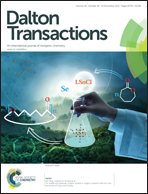Fabrication of nanocomposites composed of silver cyanamide and titania for improved photocatalytic hydrogen generation†
Abstract
Highly efficient composite photocatalysts composed of silver cyanamide (Ag2NCN) and anatase titania (TiO2) were fabricated through a chemical precipitation process of silver nitrate and cyanamide in TiO2 suspensions. The TiO2 nanoparticles around 15 nm were immobilized on the surface of rectangular Ag2NCN particles to form a hetero-structure, and the contents of TiO2 were varied to tune the structure and the photocatalytic performances. In comparison with single TiO2 or Ag2NCN, the TiO2/Ag2NCN nanocomposites exhibited a prominent improved photocatalytic activity in the hydrogen generation, and the hydrogen evolution rate (1494.0 μmol (g h)−1) was higher than most of the reported TiO2-composite photocatalysts. Based on the structure investigation, the photocatalytic mechanism of these TiO2/Ag2NCN nanocomposites was proposed. The enhanced photocatalytic activity was attributed to three points: the matched energy level between TiO2 and Ag2NCN promoted the electron–hole transfer and thus inhibited the recombination of photogenerated electrons and holes; the great electron storage capacity of metallic silver produced in the photocatalytic process also facilitated the charge separation; in addition, the expanded absorption spectrum because of the composite structure enhanced the UV and visible light response ability. These TiO2/Ag2NCN nanocomposites also presented good photocatalytic stability in the typical cycle tests. This work provided new insights into fabricating highly efficient composite photocatalysts containing silver and TiO2 for hydrogen generation.


 Please wait while we load your content...
Please wait while we load your content...